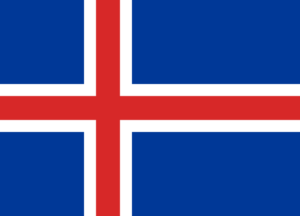Vikings came to Iceland in the 9th century. In 930 AD, the local rulers established a parliament and a constitution. The parliament is the oldest in the world called Alcingi. In 1262 Iceland united with Norway. The country then joined Norway and became part of the Danish royal family. When Norway later became independent again, Iceland remained united with Denmark.
In 1875 Iceland suffered a terrible natural disaster, the eruption of the Ascha volcano. The country suffered massive famine and the economy was devastated. Over the next 25 years, 20% of her population left the island.
In 1918, Iceland became an independent state, retaining some ties with Denmark. Iceland will rule itself, but diplomatic relations and defense will be handled by Denmark. During World War I, Iceland’s defense was taken over by the United States. In 1944 Iceland became an independent republic, and in 1946 the United States no longer had responsibility to defend Iceland. In 1951, however, the two countries again agreed to a defense pact. Iceland is the only NATO member that does not have its own military.
| Capital | Reykjavik |
| Population | 375,318 (Source: 2023 worldometer) |
| Major Cities | Reykjavik (capital), Akureyri, Húsavík, Ísafjörður, Seydisfjordur, Hafnarfjörður, Egilsstaðir, Höfn, Selfoss |
| Borders | no land borders with other countries |
| Gross Domestic Product (GDP) | $27,841,648,044 (2022 worldometer) |
| Currency | Icelandic krona (ISK) |

Iceland Major Industries: fish processing; aluminum smelting, ferrosilicon production; geothermal power, tourism
Iceland Agricultural Products: potatoes, green vegetables; mutton, dairy products; fish
Iceland Natural Resources: fish, hydropower, geothermal power, diatomite
Iceland Major Exports: fish and fish products 70%, aluminum, animal products, ferrosilicon, diatomite
Iceland Major Imports: machinery and equipment, petroleum products, foodstuffs, textiles
Total Size of Iceland: 103,000 km² (source: 2022 The world factbook)
Geographical Low Point of Iceland: Atlantic Ocean 0 m
Geographical High Point of Iceland: Hvannadalshnukur 2,110 m (at Vatnajokull glacier)
Climate of Iceland: Temperate; moderated by North Atlantic Current; mild, windy winters; damp, cool summers
General Terrain of Iceland: mostly plateau interspersed with mountain peaks, icefields; coast deeply indented by bays and fiords
World Region or Continent of Iceland: Arctic Region
Geographical Coordinates: 65 00 N, 18 00 W
Iceland Government Type: constitutional republic
Iceland Nationality: Icelander(s)
Iceland National Holiday: Independence Day, 17 June (1944)
Iceland Independence: 1 December 1918 (became a sovereign state under the Danish Crown); 17 June 1944 (from Denmark)
Iceland National Symbol: gyrfalcon
Iceland National Anthem or Song: Lofsongur (Song of Praise)
Iceland Languages Spoken: Icelandic, English, Nordic languages, German widely spoken
Iceland Religions: Lutheran Church of Iceland 85.5%, Reykjavik Free Church 2.1%, Roman Catholic Church 2%, Hafnarfjorour Free Church 1.5%, other Christian 2.7%, other or unspecified 3.8%, unaffiliated 2.4% (2004)
Iceland has no army or standing army, and Icelanders are proud of their country’s long-standing pacifist traditions. Iceland is one of the most peaceful countries in the world and its citizens enjoy a high standard of living.
The Icelandic Defense Force consists of the Icelandic Coast Guard, which patrols Icelandic waters and monitors the airspace, as well as other units such as National Security and Special Forces of the National Commission.
With geothermal hot springs such as the famous Blue Lagoon and its status as the world’s largest geothermal producer, Iceland’s unique beauty is undeniable. Icelandic folklore has tales of elves, trolls and other mystical creatures, and the country’s unique landscapes are the inspiration for many legends about magical creatures.
The capital of Iceland is Reykjavik, the largest urban area in the country. Also, most of the country’s population lives there, while the rest live in small villages and towns along the coast. Few people live in the highlands because of the harsh environment.
Almost every district in Iceland has natural hot springs. In colder countries, underground geothermal activity provides some warming, especially in wild pools. Relax and take a bath any time of the year!
Iceland experienced a total ban on beer for 74 years during Prohibition. It’s a severe drought. You can imagine the celebrations across the country when it was legalized again in 1989.
Iceland is known as the land of fire and ice because of its volcanic activity and glaciers.
With only 3 inhabitants per square kilometer, it is the least populated country in Europe.
Icelandic is one of the oldest languages in the world and has changed little since the Middle Ages.
There are no mosquitoes in Iceland (although they only recently started colonizing the country).
According to the World Happiness Report, Icelanders are one of the happiest people in the world.
Reykjavik, the capital of Iceland, is the northernmost capital in the world.
Iceland has the world’s largest geothermal power plant.
The Icelandic horse is a unique breed that has lived in isolation on the island for over 1,000 years.
Iceland is home to the world’s oldest parliament, Althing, founded in 930 AD.
Iceland is one of the few places in the world where you can see the Northern Lights.
The Icelandic flag is blue with a red cross bordered in white.
Icelanders have one of the longest life expectancies in the world, with an average life expectancy of 83.1 years.
Icelanders use geothermal energy to heat most of their homes and buildings.
Iceland has a unique Christmas tradition called Jorubokafloz, which means “Christmas Book Flood”.

